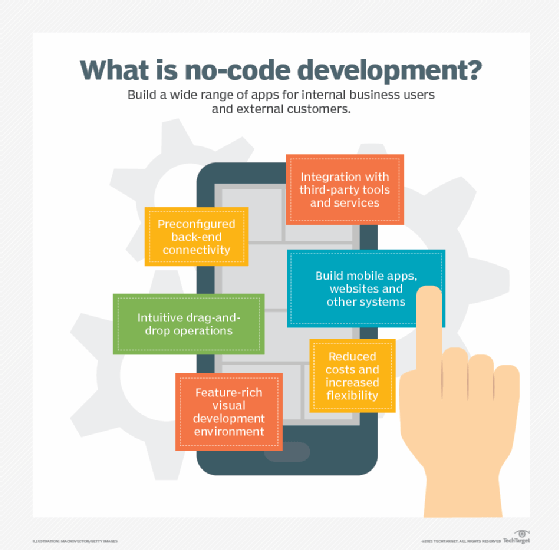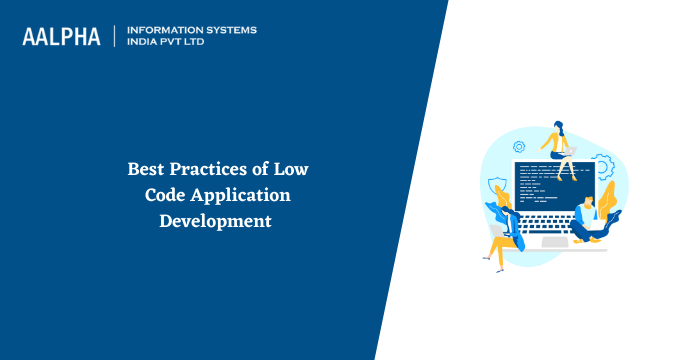Great Suggestions To Selecting Legacy application modernization with Low-code
Great Suggestions To Selecting Legacy application modernization with Low-code
Blog Article
In Regards To Integration Capabilities Low-Code Application Development Has A Lot Of Advantages.
Low-code applications offer significant advantages when it comes to integration capabilities. These are vital for developing applications that seamlessly connect with different platforms and services. Here are the benefits of pre-built APIs and connectors:
Wide Selection of Connectors. Low-code software typically includes many built-in connections to business systems that are well-known (e.g. cloud services, databases and CRM). It simplifies the integration with these systems.
API Integration: Many Low-Code platforms include out-of box API integration features that let developers easily connect external services and data resources.
Simple to use:
Drag-and-Drop Integration: A variety of integration tasks can be performed by using drag-and-drop interfaces. This allows both developers and nondevelopers to create complicated integrations using little or no programming.
Visual Workflow Designers: These tools help you understand and configure integrations more easily.
Standardized Integration Methods:
SOAP and Restful Service: Using standard web service protocols like SOAP and REST makes it easy to integrate external systems and applications.
OData and other Standards: Supporting standards like OData allows for the easy access and manipulation of data on different platforms and programs.
Real-Time Data Synchronization:
Real-time Integrations: Low-code devices allow real-time data synchronization between applications and systems, assuring that data is always up-to-date and consistent throughout the company.
Event-Driven Architecture: A few platforms can support event-driven architectures. enabling applications to respond to events in real time, which is crucial for dynamic and interactive applications.
Legacy System Integration:
Connecting old and new Systems Low-code platforms typically provide tools to integrate with older systems, allowing organizations to modernize their IT infrastructure without completely overhauling the existing system.
Data Migration Tools: These built-in tools to migrate data facilitate the transfer of data from older systems to software developed using low-code platforms.
Integration of Third Party Services:
Cloud Services Integration: The seamless integration of cloud services like AWS Azure, Google Cloud, allows for easy deployment and scaling up of applications.
Business Applications Low-code platforms can be used to connect with a variety of applications for business, such as Salesforce, SAP or Microsoft Dynamics. They can create a cohesive workflow for different business functions.
Simple Data Management
Unified Data Models Some low-code platforms provide unification of data models, which simplify managing data and integrating across different systems.
Data Connectors: Pre-configured data connectors allow easy access to and manipulation of data derived from diverse sources.
Security and Compliance
Secure Integrations: Low-code platforms ensure that integrations comply with security protocols and standards, helping to secure data both during transport as well as at rest.
Compliance Features: These platforms have features to ensure that the integration is compliant with regulations (e.g. GDPR, HIPAA), giving those who manage sensitive data peace of mind.
Extensibility:
Custom Codes and scripts. To meet more intricate requirements in integration, low-code platform usually allows the use of custom code and scripts. This provides flexibility without compromising user convenience.
Plug-in Ecosystems: A plug in ecosystem can be used to expand the capabilities of integration and allows users to add additional functionalities as needed.
Overall, the low-code platform's integration capabilities makes it an effective tool for developing interconnected apps that are scalable and efficient. They simplify the process of connecting disparate systems, increase the flow of information, and allow companies to make use of existing technology while embracing new ones, which results in a cohesive and integrated IT environment. Follow the recommended my latest blog post for Low-code Platform for application development for website examples including mobile development platforms, cross platform mobile development, rapid action development, no code platforms, rapid action development, rapid applications, microsoft azure sql, push alerts, app modernization, cloud software applications and more.
Scalability And Flexibility Are The Two Primary Benefits Of Developing Applications Using Low-Code
The creation of low-code applications has many advantages, particularly in terms of scaleability. This is important to create applications that grow with your business and be able to adapt as the business changes. These are the major advantages: Rapid Scaling
Cloud-Based Platforms: A lot of platforms for low-code are cloud-based. They let applications easily scale up and down with the cloud infrastructure. It allows businesses to manage the increased workloads without having worry about managing servers.
Auto-Scaling: The auto-scaling feature will automatically adjust the resources based on demand. This will ensure the same performance even during peak hours with no manual intervention.
Flexible Architecture:
Modular design: Low-code platforms are a excellent way to promote modular applications. This lets components be developed independently and tested, scaled, etc. Modularity allows for greater flexibility, and makes it easier to update specific parts of an application without having to change the entire system.
Microservices Integration Microservices Integration: Microservices support allows applications to be developed as a collection of loosely coupled service, increasing both scalability and flexibility.
Customizable Solutions
Extensibility. Low-code platform typically allows for custom coding or scripting. This enables developers to extend the application's functionality beyond what is offered from the box. This allows developers to satisfy their own business needs without any limitations.
Third-Party Integrations: The integration of third-party services, APIs or other types of services permits companies to expand the capabilities of their application by incorporating additional functions.
Agile Development & Deployment
Continuous Delivery and Deployment : Low-code platforms support agile methods which allow continuous integration, continuous delivery (CI/CD). This allows for the rapid release of updates and new features, ensuring that applications can evolve quickly in response to feedback from users and market changes.
Iterative Development - The low-code model permits applications to be enhanced and scaled up incrementally, reducing risk and allowing for more controlled expansion.
Resource Optimization
Efficient resource management Low-code platforms maximize resources by supplying tools to monitor and control the performance of applications. This enables resources to be utilized efficiently and can be sized up or down according to the need.
Load Balancing: Integrated load balancing features distribute workloads equally across servers, increasing the ability of the application to handle large volumes of traffic while ensuring consistency in performance.
Global Reach
Multi-Region Implementation: Low code platforms can be implemented across multiple geographical regions. This enables companies to offer users low latency access worldwide. This is vital for applications that serve users from all over the world.
Support for Localization. Inbuilt support for localizing applications makes them easily adapted to different local languages, regional needs and increases their flexibility across different markets.
Maintenance and updates
Maintenance is made easier because of the modularity and visual appeal of low-code apps makes maintenance simpler which allows quick updates and bugfixes to be applied without lengthy downtime.
Version Control: A fully integrated version control system helps keep track of changes and rollbacks. This ensures that updates can easily be deployed and previous versions restored if required.
Cost Efficiency:
Low Development Costs - By cutting down on the amount of code required, low code platforms can lower development costs. This makes it possible to scale up applications without increasing the development effort and expenditure.
Pay-As-You-Go Models A lot of low code platforms provide flexible pricing like the pay-as-you-go model that aligns costs with actual usage and growth. This provides financial flexibility.
Low-code development offers businesses many advantages, including scalability flexibility and flexibility. This allows them to create robust, adaptable and scalable apps. These platforms permit quick adaption to evolving requirements and efficient use of resources and continual enhancement. This ensures that applications can grow with the business. Check out the top wavemaker.com coding for more advice including software for app development, no code platforms, database in azure, sso azure, rapid applications, push notifications, develop web app, microsoft azure sql, paas service, mobile app development platforms and more.
Benefits Of Low-Code App Development In Terms Limitations And Customization
Low-code development is an approach that is balanced and offers significant advantages in terms of addressing limitations and allowing for customization. The main advantages are: limitations:
In overcoming Complexity Barriers:
Simplified Development: Low-code platforms cut down on complexity by providing pre-built components and templates, enabling quicker development and deployment for complicated applications.
Many platforms have guided workflows, which assist developers to navigate through complex processes. They minimize the risk of error and maintain consistency.
Solutions to scale:
Built-in Scalability: Low-code platforms typically include features that allow scalable architecture, allowing applications to take on more load without requiring significant changes.
Performance Monitoring: Integrated performance monitoring tools and optimization make sure that applications are as efficient as they can be, regardless of their size.
Security and Compliance
Integrated Security Features: Low-code systems come with built-in security measures like encryption, role-based access control, and automated compliance checks, addressing common security concerns.
Regular Updates: Platforms regularly update their security protocols and conformity measures, making sure that their applications are secure against the latest threats.
Options for Customization:
Extensibility:
Custom Code Integration : A low-code platform often allows the integration of custom code (e.g. JavaScript, Python) which enables developers to expand the functionality beyond the standard offerings.
Custom Modules and Plugins: Developers have the option to create customized modules or plugins to customize specific functionality to fit unique business needs.
APIs and integration
API Support - The extensive API support facilitates seamless integration with other systems and services and allows for complete modification.
Third-Party Platforms: Lowcode platforms are often already built with connectors to third-party apps, making it easier to integrate these applications and personalize the application.
Flexible UX/UI Designs:
Customizable Interfaces Developers are able to create and alter user interfaces in line with specific usability and branding criteria which results in a custom user experience.
Responsive Web Design Responsive Web Design: Built-in design responsive capabilities enable applications to be customized depending on the device and screen size.
Custom Business Logic:
Visual Workflow Builds Visual tools allow for the customization of workflows and business rules and to design complex customized procedures.
Conditional Logic and scripting : Platforms allow conditional logic and custom scripting to deal with specific business rules.
Data Management
Custom Data Models: Developers can create custom data models to suit specific application needs, ensuring that data handling is customized to the business needs.
Advanced Data processing: Integration and advanced data handling tools allow for customisation of data analysis and utilization within the application.
Balance Customization and Limitations
Frameworks and Standards
Low-code platforms are compliant with industry standards and best practice. This helps maintain high-quality and secure applications.
Governance Frameworks. Built-in frameworks of governance ensure that customizations will not compromise the security, compliance or integrity of the software.
Iterative Design and Feedback
Rapid prototyping: Developers are able to quickly test and prototype customizations based on the feedback of users, improving the application based on their needs.
Continuous Improvement: Low-code platforms support constant improvement, allowing continuous customization and improvement as business requirements evolve.
Empowering Users
Giving Citizen Developers the ability to be empowered by giving non-developers the capability to personalize their apps using easy-to-use interfaces as well as low-code platforms they increase the number contributors who are able to enhance and tailor application.
Training and Support Tools: A lot of platforms offer an extensive set of training and support resources to allow users to customize their applications without compromising performance or stability.
Overall, application development that is low-code offers a robust system for dealing with limitations, while providing ample opportunities for customization. This allows businesses can build and maintain applications that are functional and customized to meet their particular needs, all while maintaining the highest standards of quality, security and the ability to scale.